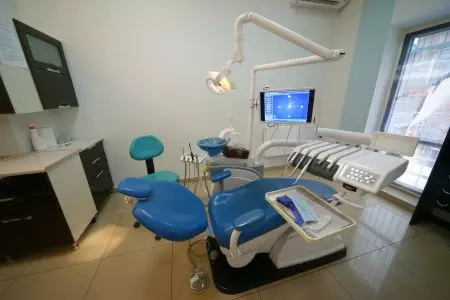- Alveolitis – what is it?
- Causes of alveolitis
- How to realise there is alveolitis: symptoms
- What is alveolitis: forms
- Diagnosis of alveolitis
- Treatment methods for alveolitis in dentistry
- Diagnosis and treatment of alveolitis after tooth extraction at Dent-House
- Frequently asked questions about the treatment of alveolitis of the socket
- Specialists
The treatment of cavity alveolitis is a process aimed at eliminating complications after tooth extraction. The procedure is easy if you entrust it to professionals. Make an appointment at the Dent-House clinic in Odessa and forget about the unpleasant experience of treatment forever!
Alveolitis – what is it?
Alveolitis (also known as “dry socket”) is a complication of tooth extraction. Improper wound healing leads to inflammation of the alveolar bone that surrounds the extraction site. This condition is characterised by severe pain, bad breath and possible pus discharge.
Alveolitis is mainly due to impaired wound healing after tooth extraction, when the blood clot that normally forms in the hole is destroyed or absent. This leads to infection and inflammation of the bone tissue. Treatment is aimed at relieving inflammation, relieving pain and stimulating the wound healing process.
Causes of alveolitis

Alveolitis can develop due to:
- prolonged bleeding after a tooth extraction that results in loss or destruction of a blood clot;
- traumatic tooth extraction;
- of bacteria or infection getting into the wound;
- violation of the protocol of care and oral hygiene after tooth extraction – rinsing, hard food, violation of wound integrity by stranger objects;
- An infectious process that was present before the tooth was extracted, such as periodontitis;
- certain diseases, like diabetes;
- blood clotting disorders;
- Regularly taking certain medicines, such as those containing oestrogen.
Also, the risk of developing alveolitis is due to advanced age, smoking, low immunity, and chronic infections in the body.
How to realise there is alveolitis: symptoms
Symptoms such as these usually indicate the onset of alveolitis:
- Severe pain at the site of tooth extraction. It can be dull, wavy or sharp, and can go to the ear, temple, jaw or neck.
- Bad breath that doesn’t go away even after brushing your teeth.
- Unpleasant taste in the mouth.
- Oedema.
- You can see the bone in the hole.
- Purulent discharge at the site of tooth extraction.
There may also be other signs – enlarged lymph nodes, fever, redness of the gums.
If you notice these symptoms after a tooth extraction, contact a dentist at Dent-House in Odessa as soon as possible. The doctor will help you to cope with this problem and get rid of the pain.
What is alveolitis: forms
There are two main forms of alveolitis:
- Dry alveolitis. This is the most common form. It occurs when the blood clot that normally forms in the hole after a tooth extraction is destroyed or missing. This leaves the bone tissue exposed, causing severe pain and increasing the risk of infection.
- Moist (purulent) alveolitis. This type is characterised by the formation of a pus clot in the hole after a tooth extraction due to infection. It is a more serious form of alveolitis that leads to severe pain, swelling and even fever.
The forms of alveolitis have different symptoms and treatments. It is important to see a dentist at the first sign of the disease for diagnosis and appropriate treatments. How much does it cost to treat? The cost depends on your individual case.
Diagnosis of alveolitis
Alveolitis is usually diagnosed by the dentist or surgeon who extracted the tooth. Here’s how it happens:
- The doctor will examine the site where the tooth was extracted to assess if there are signs of alveolitis. He or she will look for a hollow hole, odour, pus discharge or other signs of inflammation.
- The dentist uses instruments – special probes or irrigation syringes – to examine the hole.
- It’s important to tell your doctor about all of your symptoms – this will help them better understand your condition and make an accurate diagnosis.
- Your doctor may order radiographs to take a closer look at the bone structure in the area of the extracted tooth and to identify other problems that may be affecting wound healing.
If the diagnosis is confirmed, the doctor at Dent House Clinic will determine the best treatment plan for your case.
Treatment methods for alveolitis in dentistry

Here are the main treatments for alveolitis in dentistry:
- The doctor thoroughly rinses the hole after tooth extraction with antiseptic solutions to remove food debris and bacteria.
- If there are tooth or root remnants present in the hole that could cause irritation or infection, they are also removed.
- The doctor will apply antiseptic medication to the hole or place a tourniquet with medicine. This will help fight the infection and speed up the healing of the wound.
- Painkillers are prescribed to relieve the condition.
- If a pus clot forms in the hole, the doctor will flush the hole and, if necessary, place a drain to remove the pus discharge.
- In most cases, the doctor prescribes a course of antibiotics to fight the infection and prevent it from spreading.
- The dentist will schedule appointments to monitor the healing of the hole. It is important not to miss appointments with the dentist.
The specific treatment plan will depend on the severity of the situation, the presence of complications and the individual characteristics of the patient.
Diagnosis and treatment of alveolitis after tooth extraction at Dent-House
If you observe any symptoms of alveolitis, make an appointment at the Dent House Family Dentistry Clinic right away, even if you did not have a tooth extracted with us. A qualified dentist will see you as soon as possible, diagnose and prescribe treatment.
Our benefits:
- a wide range of services for the whole family, including granuloma treatment;
- innovative equipment;
- personalised approach;
- qualified specialists with many years of experience;
- reasonable prices;
- positive feedback from patients.
Call the numbers listed on the website to find out how much it costs to treat alveolitis or to make an appointment at the Dent-House Clinic in Odessa.
Frequently asked questions about the treatment of alveolitis of the socket
🦷 What is alveolitis and its symptoms?
😁 What are the causes of alveolitis?
🦷 What are the methods of treating alveolitis in dentistry?
😁 How quickly do alveolitis symptoms go away after treatment?
Cost of services
Specialists

Semenyuk Ekaterina Sergeevna
Dentist

Kirilyuk Yulianna Ivanovna
Pediatric dentist

Furduy Ekaterina Sergeevna
Pediatric dentist








